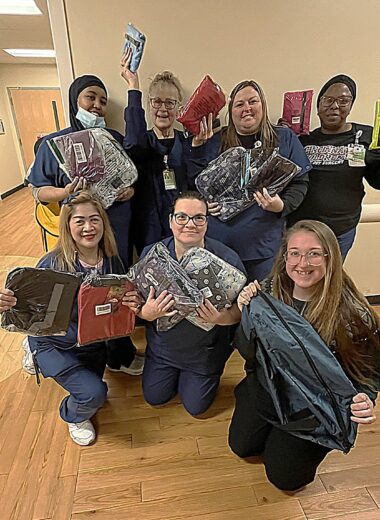NASA Recognizes Crothall’s Joe Irons for Prestigious Safety Award

NASA Recognizes Crothall’s Joe Irons for Prestigious Safety Award
Crothall Unit Director Joseph Irons is widely known at the National Aeronautics and Space Administration (NASA) facility in West Virginia as a person who finds a solution to nearly any problem. To recognize his outstanding work, Irons recently received NASA’s prestigious “Yes, If,” award, a coin which honors people who exemplify NASA’s spirit of ingenuity, creativity, and commitment to safety.
Irons has worked 21 years for Crothall at NASA’s Katherine Johnson Independent Verification and Validation (IV&V) Facility in Fairmont, West Virginia. He oversees Facilities Management and Environmental Services, covering nearly 50,000 square feet and works daily with engineers, computer programmers, and other technology specialists who ensure the safety and success of all software nationwide for NASA’s highest-profile missions.
The site is named after one of the first Black women to work as a NASA scientist whose mathematical calculations were critical to the success of the first and subsequent U.S.-crewed spaceflights. She was portrayed by Taraji P. Henson as a lead character in the 2016 film “Hidden Figures.”
“Joe always looks at a problem with an open mind and works collaboratively with the NASA team to provide cost-effective, yet safe solutions,” says Dave Sheldon, the NASA IV&V Operations and Maintenance lead who nominated Irons for the award. “He embodies our award by continually exhibiting a spirt of ingenuity, creativity, and a commitment to everyone’s safety.
Irons was one of only six people nationwide to receive the award, which was presented to him by Russ DeLoach, NASA’s chief for the Office of Safety and Mission Assurance.
Irons Oversees Projects Critical to NASA’s Success
A licensed electrician who grew up in a family construction business, Irons began working for Crothall when he was 29 years old. Shortly after joining the company at the NASA facility, he was trained as a technician to maintain its data center and his career took off. He was promoted to unit director in 2015 and, with a current team of seven people, has built a strong track record of accomplishments.
As part of the award, Irons was cited the following achievements:
During the COVID-19 pandemic, Irons helped design and consolidate several key operations into one building. These included NASA’s 20,000-square-foot data center; a software simulation laboratory; three Special Function Rooms; a 1,200-square-foot experimental solid oxide fuel cell system; and more than 20,000-square feet of office and conference rooms.
The new data center, originally designed in 1993, was a key accomplishment. “We redesigned it and modernized the whole electrical distribution system with safety as a top priority,” Irons says.
While this massive project was in progress, Irons also developed a plan to keep everyone safe during the pandemic. He separated the building into areas assigned to only critical staff members. He also worked with NASA Chief Medical Officer Dr. Sheryl Ashton Jones to keep his entire team working onsite to complete current construction projects. His team was required to be onsite to support remaining computer systems used at that time by the National Oceanic and Atmospheric Administration and other construction projects.
“Flexibility was the key to keep everyone safe,” Irons says. “I set up self-serve stations for every team and kept them stocked with everything they needed to comply with COVID regulations, as well as signs above the stations updating them about the new mandates. I kept teams small and well monitored, letting people isolate if they needed, and accommodated people with different needs as they arose.”
Designing and Building Secure Rooms
His work has also been critical in supporting the design and build-out of three Special Function Rooms for NASA.
Irons, who holds a bachelor of fine arts degree from West Virginia University, used computer software to develop schematic designs that would help NASA managers understand the look and size of the rooms – a much better way to visualize the rooms instead of typical engineering drawings.
“I used to work as an artist building playgrounds and public artworks in rural West Virginia for the National Endowment for the Arts. By building playgrounds, I found out that engineers and architects speak the same language as sculptors.
“By using the right software, we were able to show design details instead of trying to the figure out engineering drawings. It made it easier for them to make key decisions and move the project forward.”
Irons and his team have also designed and built various infrastructure projects. One of the biggest and most important was when we hung Katherine Johnson’s name on the building. “She was an amazing, and we felt the pressure to make her family proud,” Irons says.
Demonstrating his attention to detail, Irons has installed one 360-degree camera on all construction projects to monitor the progress of each project and fix any issues. “Our client liked it because they can use the camera to inspect the craftsmanship or problems at any time.
“I’m also able to reach out to the team about things I saw that were potentially unsafe as well as have a complete record of the build.”
Building the Ultimate Client Relationship
Irons was nominated for the “Yes, If” award by Dave Sheldon, Crothall’s primary contact at NASA who works, in effect, as the site’s chief operating officer. Sheldon joined NASA not long after Irons did 21 years ago. The two men have worked together on numerous projects and built a bond over two decades that enables them to speak candidly and find the right solutions to a project, often with few resources.
Irons says the level of trust built over many years is enhanced by the communications style embraced by he and Sheldon. “We both have small teams with few resources that need to find solutions on many issues,” says Irons. “We meet nearly every day, and it’s always in person. We know that’s the best way to overcome any obstacles and get to the right solution.”
By building the working relationship with Sheldon and others over such a long period, Irons has been able to provide a level of service that Crothall aspires to achieve with each client.
“The innovative ways Joe and his team have served his client over the years have been vital to optimizing facility operations at NASA,” says Aric Alexander, Crothall’s Regional Director of Operations. “Joe has demonstrated a passion for excellence and a willingness to always do what is needed to complete a project that fits the client’s needs. He is an incredible individual and the award is well deserved.”
Related Posts
Let’s Talk About the Right Solution for Your Organization
Get in touch to discuss how Crothall Healthcare’s services and solutions can help your healthcare organization exceed its goals. You’ll learn more about:
- The transparency we bring to outsourced support services
- How we design customized solutions for your unique needs
- The technology and innovation Crothall delivers across all our services






